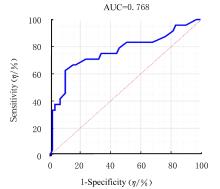吉林大学学报(医学版) ›› 2022, Vol. 48 ›› Issue (3): 766-772.doi: 10.13481/j.1671-587X.20220326
• 临床研究 • 上一篇
术前血糖水平对糖尿病患者行输尿管软镜碎石术后发生感染相关并发症的影响
翟永鑫1,塔怀峰2,张逸1,孙启甲1,张明1,冯树强1( ),李然伟1(
),李然伟1( )
)
- 1.吉林大学第二医院泌尿外科,吉林 长春 130041
2.吉林大学第二医院手术室,吉林 长春 130041
Effect of preoperative glycemic level on infection-related complications of diabetic patients after flexible ureteroscopic lithotripsy
Yongxin ZHAI1,Huaifeng TA2,Yi ZHANG1,Qijia SUN1,Ming ZHANG1,Shuqiang FENG1( ),Ranwei LI1(
),Ranwei LI1( )
)
- 1.Department of Urology,Second Hospital,Jilin university,Changchun 130041,China
2.Department of Operating Room,Second Hospital,Jilin University,Changchun 130041,China
摘要: 观察2型糖尿病(T2DM)患者行输尿管软镜碎石术(FURL)后出现感染相关并发症的影响因素,探讨T2DM患者术前血糖水平与发生术后感染相关并发症的关系,为T2DM患者在接受FULR术后发生感染相关并发症的早期预防及治疗提供参考。 选择接受FURL手术治疗的83例上尿路结石并发T2DM患者进行回顾性分析,根据术后是否发生感染将其分为感染组和非感染组,对比2组患者的临床资料,单因素和多因素Logistic回归分析筛选出发生术后感染的独立影响因素,受试者工作特征(ROC)曲线界定术前血糖控制良好的水平,据此将患者分为血糖控制良好组(血糖水平≤7.7 mmol·L-1)和血糖控制不佳组(血糖水平>7.7 mmol·L-1),比较2组T2DM患者术后感染相关并发症发生频数和平均术后住院天数。 单因素Logistic回归分析,术前血糖水平、结石直径≥2 cm、术前尿常规白细胞计数>10/HP、术前尿培养阳性和手术时间≥90 min为T2DM患者术后感染事件的可能影响因素;二元多因素Logistic回归分析,术前血糖水平、手术时间≥90 min、结石直径≥2 cm和术前尿培养阳性为T2DM患者术后出现感染相关并发症的独立影响因素。ROC曲线分析,以术前血糖7.7 mmol·L-1作为截断值时,预测患者术后感染相关事件的灵敏度为70.37%,特异度为96.43%。血糖控制良好组患者术后感染相关并发症发生频数和术后平均住院天数均低于血糖控制不佳组(P<0.05)。 术前血糖水平、术前尿培养阳性、手术时间≥90 min和结石直径≥2 cm是T2DM患者行FURL术后发生感染并发症的独立影响因素。以术前血糖水平≤7.7 mmol·L-1作为血糖控制良好的标准,能够有效降低患者的术后感染率,缩短术后住院时间。
中图分类号:
- R587.1


